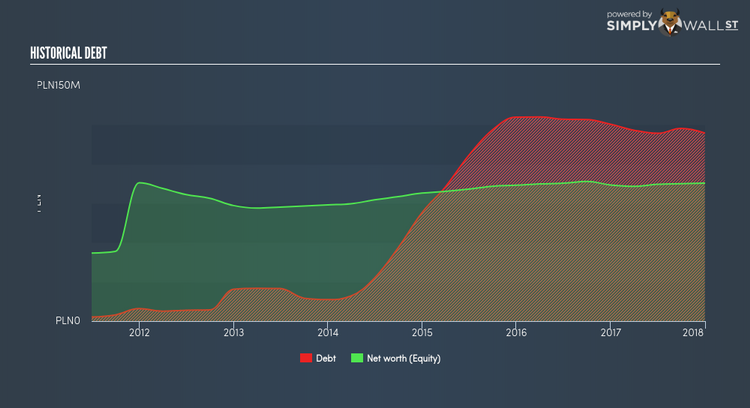Is PCC Intermodal SA.’s (WSE:PCI) Balance Sheet A Threat To Its Future?

Investors are always looking for growth in small-cap stocks like PCC Intermodal SA. (WSE:PCI), with a market cap of ZŁ207.10M. However, an important fact which most ignore is: how financially healthy is the business? Assessing first and foremost the financial health is crucial, since poor capital management may bring about bankruptcies, which occur at a higher rate for small-caps. Here are a few basic checks that are good enough to have a broad overview of the company’s financial strength. Nevertheless, I know these factors are very high-level, so I recommend you dig deeper yourself into PCI here.
How does PCI’s operating cash flow stack up against its debt?
PCI has sustained its debt level by about ZŁ119.76M over the last 12 months made up of current and long term debt. At this current level of debt, PCI’s cash and short-term investments stands at ZŁ11.27M , ready to deploy into the business. Moreover, PCI has produced ZŁ7.97M in operating cash flow over the same time period, leading to an operating cash to total debt ratio of 6.65%, indicating that PCI’s current level of operating cash is not high enough to cover debt. This ratio can also be interpreted as a measure of efficiency as an alternative to return on assets. In PCI’s case, it is able to generate 0.067x cash from its debt capital.
Can PCI meet its short-term obligations with the cash in hand?
With current liabilities at ZŁ60.02M, it seems that the business has not maintained a sufficient level of current assets to meet its obligations, with the current ratio last standing at 0.91x, which is below the prudent industry ratio of 3x.
Is PCI’s debt level acceptable?
With total debt exceeding equities, PCI is considered a highly levered company. This is not unusual for small-caps as debt tends to be a cheaper and faster source of funding for some businesses. No matter how high the company’s debt, if it can easily cover the interest payments, it’s considered to be efficient with its use of excess leverage. A company generating earnings after interest and tax at least three times its net interest payments is considered financially sound. In PCI’s case, the ratio of 1.28x suggests that interest is not strongly covered, which means that lenders may refuse to lend the company more money, as it is seen as too risky in terms of default.
Next Steps:
PCI’s high debt levels is not met with high cash flow coverage. This leaves room for improvement in terms of debt management and operational efficiency. In addition to this, its low liquidity raises concerns over whether current asset management practices are properly implemented for the small-cap. I admit this is a fairly basic analysis for PCI’s financial health. Other important fundamentals need to be considered alongside. I recommend you continue to research PCC Intermodal to get a more holistic view of the stock by looking at:
Valuation: What is PCI worth today? Is the stock undervalued, even when its growth outlook is factored into its intrinsic value? The intrinsic value infographic in our free research report helps visualize whether PCI is currently mispriced by the market.
Historical Performance: What has PCI’s returns been like over the past? Go into more detail in the past track record analysis and take a look at the free visual representations of our analysis for more clarity.
Other High-Performing Stocks: Are there other stocks that provide better prospects with proven track records? Explore our free list of these great stocks here.
To help readers see pass the short term volatility of the financial market, we aim to bring you a long-term focused research analysis purely driven by fundamental data. Note that our analysis does not factor in the latest price sensitive company announcements.
The author is an independent contributor and at the time of publication had no position in the stocks mentioned.

